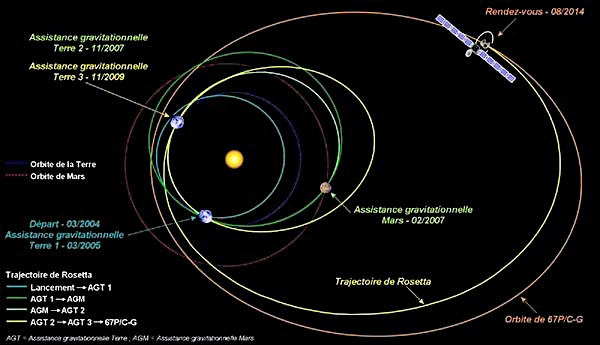
Image description: The long journey of over 6 billion km of the Rosetta probe with all its trajectories and various rendezvous. Image source: CNES, Sébastien Rouquette.
The Rosetta probe of the European Space Agency was launched from the Kourou Space Center (French Guiana) on March 2, 2004, for a very long journey of 6 billion km.
The main objective of the mission was to reach the periodic comet (1 passage every 6.59 years) Churyumov-Gerasimenko "Choury", analyze the composition and structure of its nucleus, its outgassing as it approaches the Sun, and then land Philae, the 100 kg lander robot, on its surface.
The Rosetta mission has already provided numerous data collected during flybys of the planet Mars in February 2007, the small asteroid (2867) Steins (≈5 km) on September 5, 2008, and the large asteroid Lutetia (95.8 km) on July 10, 2010.
Rosetta had been in hibernation since June 2011, more than 800 million km from the Sun, near Jupiter's orbit, and its automatic wake-up was scheduled 957 days later. On January 20, 2014, at 9 million km from the comet, the probe warmed up its navigation instruments, stopped its rotation, and pointed its main radio antenna towards Earth to transmit a signal of life.
The signal was received by the two NASA ground stations Goldstone and Canberra on January 20, 2014, at 18:18 UTC, during the first opportunity window that the probe had to communicate with Earth. Immediately confirmed by the ESA space operations center in Darmstadt, and the success of the wake-up was announced as "Hello, world" via the Twitter account.
From January 20, scientists conducted essential health checks on the satellite, and the eleven instruments of the orbiter and the ten instruments of the lander will be turned on and prepared for the study of comet 67P/Churyumov-Gerasimenko.
For two months, Rosetta will perform a detailed mapping of the comet's surface and precise measurements of its gravity, mass, shape, and the gases in its dusty atmosphere or coma. Then, scientists will choose a landing site for Philae, the 100 kg lander robot.
The perilous landing of Philae is scheduled for November 11, 2014. The gravity on the comet's surface is so weak that Philae will have to use harpoons to anchor itself in the ice to prevent it from bouncing back into space after landing. We will then receive very high-resolution photos of the comet's icy surface. The robot will drill the soil up to 23 cm deep and analyze the samples in its laboratory.
The comet will reach its closest distance to the Sun (185 million km) on August 13, 2015, and will be between the orbits of Earth and Mars. Rosetta will follow the comet for the rest of 2015.
Comets are the guardians of the past, the wanderers of the sky, the messengers of space that carry the keys to our origin. Scientists deploy a lot of imagination to collect messages from primordial matter. In 1986, a probe photographed Halley's Comet from very close (600 km), bringing back extraordinary images of the nucleus.
Comets date back to a time when the primitive solar system had not yet formed the planets. 5 billion years ago, a supernova exploded. The cloud of gas and dust condensed to give birth to the Sun at the center, and all around, a flattened rotating gaseous disk filled with bodies moving in all directions.
Some of these bodies clumped together to form the planets, but others, too far from the center, orbited randomly due to perturbations in the icy regions of the solar system. A few icy objects left the cloud one day to plunge towards the Sun.
Heated by the Sun, their gas evaporated, a long mane unfurled, and the small bodies became comets. This is why comets contain the oldest organic molecules in the Solar System.
Rosetta will be the first probe to orbit a comet and deposit a scientific laboratory, the lander robot Philae, on its surface.
N.B.:
Following the failure of the European Ariane 5 rocket in December 2002, the Comet Churyumov-Gerasimenko was chosen over the small comet (1.2 km in diameter) 46P Wirtanen, which was the initial target of the mission. Churyumov-Gerasimenko (6.59 years) and Wirtanen (5.4 years) are short-period comets.
N.B.:
The Rosetta Stone, discovered in 1799, is an ancient Egyptian stele inscribed with three versions of the same text, which allowed the decipherment of hieroglyphs in the early 19th century. At the top of the stone, the text is in Egyptian hieroglyphs, in the center, the same text in Demotic script, and at the bottom in Ancient Greek. The Rosetta Stone measures 112.3 cm in height, 75.7 cm in width, 28.4 cm in thickness, and weighs ≈760 kg. Philae was an ancient Egyptian city on the banks of the Nile, which housed one of the best-preserved temples of Isis. Since the commissioning of the Aswan High Dam in 1970, Philae is now just a rock emerging from the lake. All the constructions placed on the granite soil of Philae, stone by stone, were transported to another granite islet, Aguilkia.